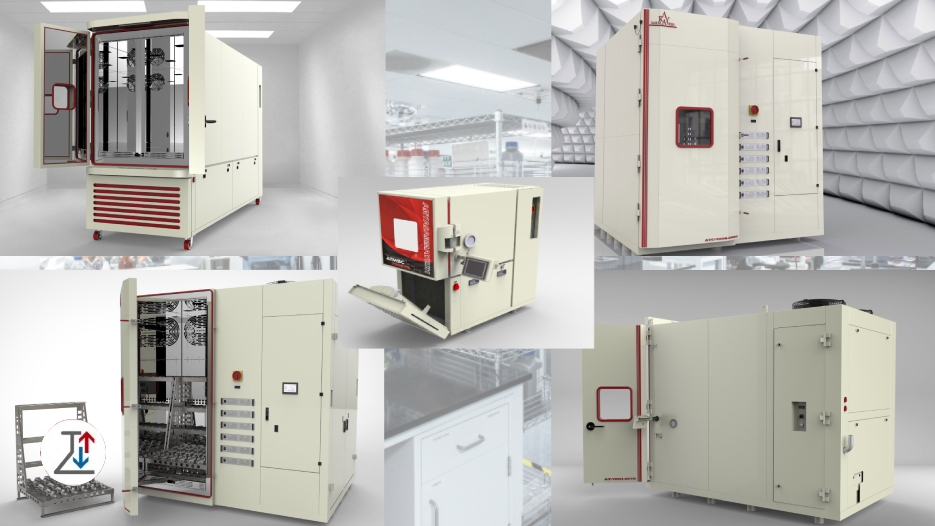
What Is a Chamber?
A chamber, often called a laboratory chamber, is a specially designed enclosed space that allows precise control over environmental conditions such as temperature, humidity, pressure, thermal shocks, light exposure, dust, and more. These chambers are widely utilized across various industries to evaluate the quality, durability, and performance of components, equipment, and materials.
Industrial Uses of Chambers
During manufacturing, products must undergo testing under real-life or even more extreme conditions to ensure they function reliably and last long. Chambers serve as essential tools in this process by providing controlled environments. Typical applications include:
- Assessing how electronic parts withstand high temperature and humidity
- Testing automotive components under extreme heat or cold
- Evaluating battery performance amid rapid temperature changes
- Simulating different weather conditions for pharmaceutical or industrial products
Key Differences Among Chambers
Chambers differ in terms of size, shape, temperature and pressure ranges, construction materials, additional equipment, and ease of maintenance.
Common Types of Test Chambers
- Temperature Chambers: These are designed to simulate a wide temperature range, often from below freezing, up to very high temperatures (e.g., -70°C to +180°C). They’re typically used for testing electronics, semiconductors, and printed circuit boards, as well as assessing materials’ performance at extreme temperatures.
- Temperature and Humidity Chambers: Also known as climatic chambers, these units regulate both temperature and relative humidity (RH), making them some of the most versatile chambers available. They offer humidity control from 10% up to 98% RH and allow simultaneous adjustment of temperature and humidity, often with programmable testing cycles. Industries like automotive companies, healthcare, aerospace, and electronics commonly use these chambers.
- Thermal Shock Chambers: These consist of two or three separate compartments set to very high and very low temperatures. Test samples are rapidly transferred between these compartments to evaluate their resistance to sudden temperature fluctuations. This helps identify potential cracking, failures, or operational faults.
- Vacuum Chambers: Designed to simulate low-pressure environments such as space. These chambers are used for testing aerospace equipment and analyzing material behavior under vacuum or reduced pressure conditions.
- UV Test Chambers: These chambers expose materials to sunlight, ultraviolet (UV), or artificial light to study effects such as color fading or the durability of printed texts and packaging.
- Dust Chambers: are Used to verify equipment resistance against dust penetration, especially for compliance with standards like IP5X and IP6X.
- Rain or Spray Test Chambers: Designed to test product resistance against moisture, rain, or simulated acid rain, often applied to outdoor electronics and automotive parts.
- Pressure Test Chambers: These simulate various pressure conditions to study how materials perform under different pressure levels.
Advantages of Using Test Chambers
Employing test chambers help reduce product risks by detecting flaws before market release, improve product quality and customer confidence by proving durability, cut costs by minimizing defective product returns, and ensure compliance with international standards such as ISO, IEC, ASTM, and MIL-STD.
Materials Used in Chamber Construction
Depending on the application, chambers are built from materials like aluminum, glass, polymers, stainless steel, titanium, ceramics, and etc.
Tips for Selecting the Right Chamber
When choosing a chamber, consider the type of test required (temperature, humidity, shock, light, dust, etc.), the operational temperature and humidity range, internal volume to accommodate samples testing, testing program complexity (single or multiple stages), and data reporting and software integration capabilities.
Summary
Test chambers are indispensable instruments in modern laboratories and industries, playing a critical role in guaranteeing product quality. Selecting an appropriate chamber and performing thorough testing can be the deciding factor between a successful product and one that fails. If your work involves sensitive sectors like automotive industries, pharmaceutical, electronics, military, or aerospace, utilizing test chambers isn’t optional—it’s essential.
About Aria Sarmayesh
Aria Sarmayesh, a knowledge-driven company, leads in manufacturing temperature and environmental test chambers, vacuum ovens, explosion-proof ovens, laboratory chillers, ultra-low temperature chillers, mini chillers, and industrial dehumidification systems, all developed with the expertise of Iranian engineers.
For more information, visit the Aria Sarmayesh product page or contact the sales manager to order chambers and other products.